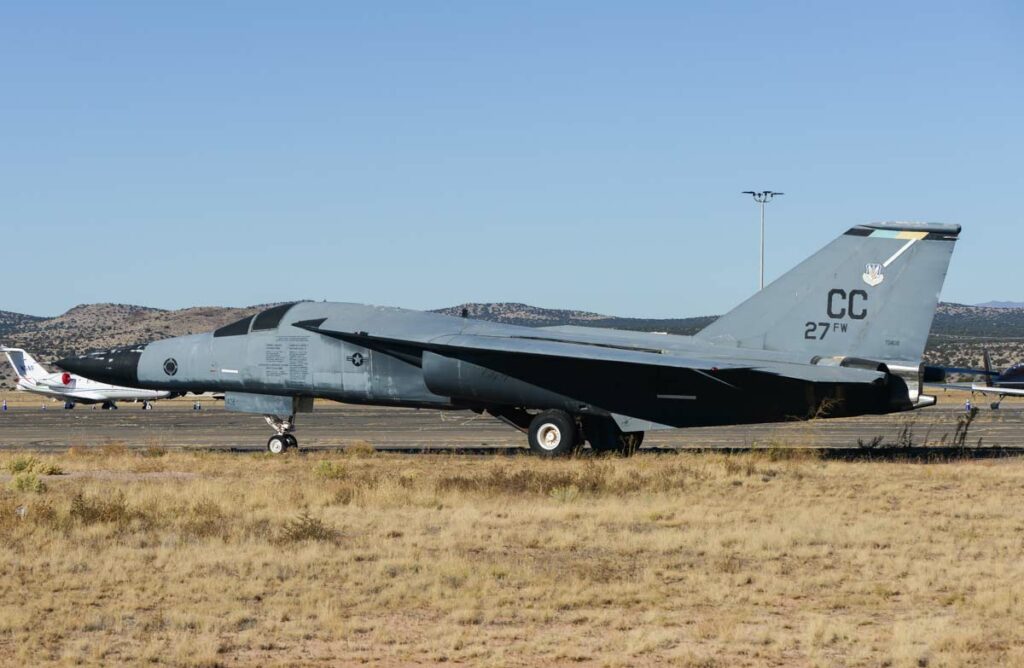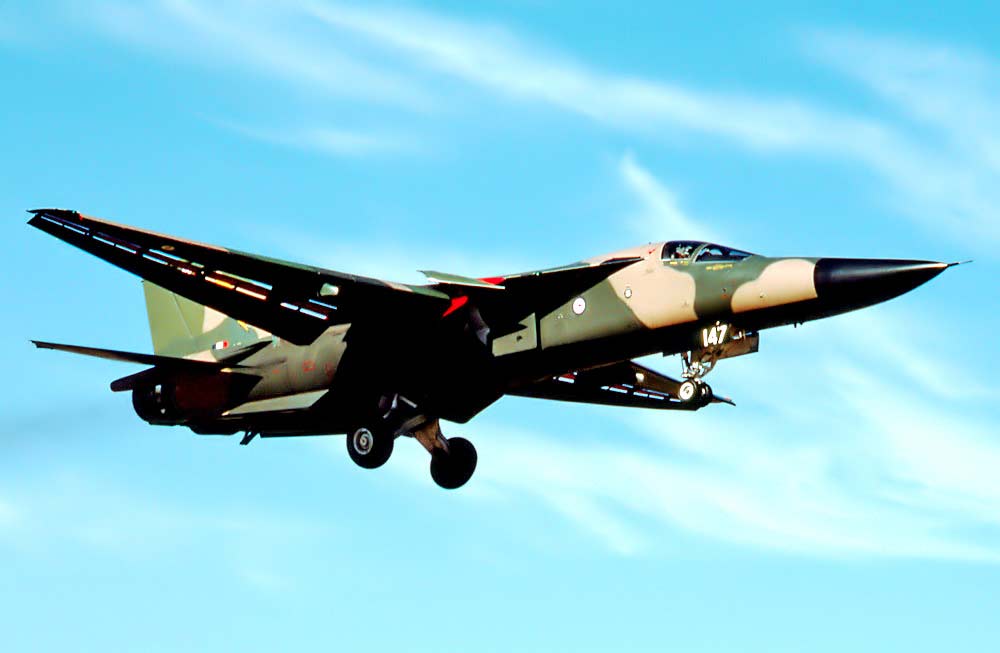A versatile, tactical strike aircraft with variable-sweep wings, designed for deep penetration bombing.
In Brief
The General Dynamics F-111K, a variant of the F-111 Aardvark, was an American supersonic, medium-range interdictor and tactical attack aircraft. It featured variable-sweep wings, a twin-engine layout, and terrain-following radar, enabling low-level, high-speed flight. Its design was tailored for deep penetration strike capabilities, carrying a vast array of conventional and nuclear munitions. The F-111K variant was specifically intended for the UK, incorporating adaptations from F-111A and F-111E models, but the order was eventually cancelled.

History of the Development of the General Dynamics F-111K (Aardvark)
The General Dynamics F-111K Aardvark’s development story intertwines with the technological, military, and political narratives of the 1960s and 1970s. Originating from the United States’ need for a versatile, all-weather attack aircraft, the F-111 was groundbreaking, introducing variable-sweep wings and afterburning turbofan engines, which epitomized the era’s technological advancements.
The F-111K was a specific variant designed for the British Royal Air Force (RAF) during the late 1960s. This model combined elements from the F-111A and F-111E variants, tailored to meet the RAF’s stringent requirements for a long-range interdictor. The genesis of the F-111K coincided with Britain’s pressing need to replace its aging fleet of V-bombers and Canberra bombers, with the F-111 offering a promising solution due to its advanced capabilities and versatility.
The program was launched amidst a period of intense technological competition and rapid advancements in aviation. The strategic context was dominated by the Cold War’s demands, necessitating capabilities for deep penetration strikes, nuclear deterrence, and adaptability to various mission profiles. The F-111K’s development was propelled by these requirements, aiming to provide the RAF with a cutting-edge aircraft capable of fulfilling a multitude of roles, from strategic bombing to tactical strike.
The first flight of an F-111 variant occurred in December 1964, but the F-111K itself was set to take flight in the late 1960s. However, the project encountered numerous challenges, including rising costs and political contention, leading to its eventual cancellation before the F-111K could fully manifest its potential.
The Aardvark did not receive a specific NATO nickname unique to its variant; instead, it was commonly known by its original moniker, “Aardvark,” a testament to its all-encompassing capabilities and the anticipated role within NATO’s strategic framework, had its deployment with the RAF proceeded.
Design of the General Dynamics F-111K (Aardvark)
The design of the F-111K was a testament to the era’s cutting-edge aviation technology, encapsulating the needs and aspirations of tactical and strategic air power. The aircraft boasted variable-sweep wings, allowing for optimal aerodynamic performance across a broad range of speeds and mission requirements. This feature enabled the F-111K to excel in both high-speed, low-altitude penetration and slower, high-altitude loitering, with wing sweep angles ranging from 16 degrees for high-speed dash to 72.5 degrees for short field landings.
Measuring over 73 feet in length and with a wingspan adjustable up to 63 feet, the F-111K was designed to carry a considerable payload, up to 31,500 pounds of ordnance, including conventional bombs, nuclear weapons, and advanced missile systems. Its twin-engine configuration, featuring Pratt & Whitney TF30 turbofans, provided the thrust necessary for supersonic speeds, complemented by afterburners for extra power during critical mission phases.
The aircraft’s avionics were state-of-the-art, incorporating advanced navigation, targeting systems, and a pioneering terrain-following radar, enabling it to fly at low altitudes in all weather conditions, avoiding enemy radar detection. However, the complexity and sophistication of its design also brought challenges. The F-111K was expensive, technically complex, and its development was marred by cost overruns and technical issues, leading to debates over its affordability and operational viability.
Despite these challenges, the design of the F-111K represented a significant leap in combat aircraft capabilities, offering unmatched versatility and potential for strategic impact. Its cancellation left questions about what might have been, had it been fully operationalized and integrated into the RAF’s arsenal.
Performance of the General Dynamics F-111K (Aardvark)
The General Dynamics F-111K Aardvark was engineered to deliver formidable performance, embodying the pinnacle of Cold War-era military aviation technology. It was powered by two Pratt & Whitney TF30-P-100 turbofan engines, each capable of producing 25,100 pounds of afterburner thrust, propelling the aircraft to speeds exceeding Mach 2.5 at altitude. The F-111K’s design allowed for a substantial operational range, significantly enhanced by its variable-sweep wings, which facilitated efficient high-speed cruising and extended loitering capabilities, depending on the mission requirements.
The aircraft boasted a maximum takeoff weight of around 100,000 pounds, demonstrating its capacity to carry a large arsenal of weapons, including air-to-ground missiles, bombs, and possibly nuclear ordnance. Its operational ceiling exceeded 60,000 feet, enabling high-altitude strategic operations, while its sophisticated terrain-following radar allowed for low-level, high-speed flight, evading enemy radar and surface-to-air missiles.
Comparatively, the F-111K was designed to outperform contemporaneous aircraft in terms of range, payload, and versatility. Its closest counterparts, like the Soviet Su-24 Fencer, were formidable but did not match the F-111’s technological advancements and multi-role capabilities. The F-111K’s ability to execute deep penetration bombing missions at high speeds and low altitudes, combined with its significant payload capacity, set it apart from other aircraft of the era.
Variants of the General Dynamics F-111K (Aardvark)
The F-111 series had several variants, each tailored for specific roles. The F-111K, intended for the British RAF, was a unique blend of the F-111A and F-111E models, incorporating various improvements to suit UK specifications. Other notable variants included:
- F-111A: The initial production version, serving as the USAF’s tactical bomber.
- F-111E: An improved version with enhanced air-to-ground capabilities.
- F-111F: Featuring advanced avionics, improved engines, and greater payload capacity.
- FB-111A: A strategic bomber variant with longer range and heavier payload.
Each variant was designed with specific missions in mind, from ground attack and strategic bombing to electronic warfare and reconnaissance, demonstrating the F-111’s adaptability and versatility across different combat scenarios.

Military Use and Combat of the General Dynamics F-111K (Aardvark)
While the F-111K never saw active service due to its cancellation, the F-111 series significantly impacted military aviation, setting standards for future combat aircraft. Its armament capacity was exceptional, capable of carrying a vast array of munitions, including precision-guided weapons, free-fall bombs, and nuclear weapons. The aircraft’s internal weapons bay and external hardpoints allowed for a versatile loadout, adaptable to various mission requirements.
The F-111’s operational history in the U.S. Air Force showcases its combat effectiveness, particularly in Vietnam, where it conducted strategic bombing, close air support, and electronic warfare missions. Its later use in the Gulf Wars further demonstrated its capabilities in precision strike and deep penetration roles, proving its worth on modern battlefields.
Competing aircraft of the era included the Soviet Su-24 and the American B-1B Lancer, each with its strengths but neither offering the F-111’s unique combination of speed, versatility, and radar-evading capabilities. The F-111 was eventually succeeded by more modern aircraft like the F-15E Strike Eagle and the F-35 Lightning II, which incorporated stealth technology and advanced avionics, building on the F-111’s legacy of innovation.
The F-111’s export potential was limited, with Australia being the only foreign operator, using the F-111C variant. The aircraft’s complex maintenance requirements and high operational costs were factors in its limited adoption. However, its service with the Royal Australian Air Force demonstrated the platform’s effectiveness, particularly in long-range strike roles and maritime surveillance.
The General Dynamics F-111K Aardvark stands as a remarkable chapter in aviation history, embodying the technological ambition and strategic vision of its time. Despite its cancellation, the F-111K’s intended capabilities highlighted the evolving requirements of modern warfare, emphasizing versatility, payload capacity, and the ability to operate in contested environments. The legacy of the F-111 series continues to influence today’s combat aircraft, reflecting a period of rapid innovation and the perpetual quest for aerial superiority.
Back to the Bombers section.